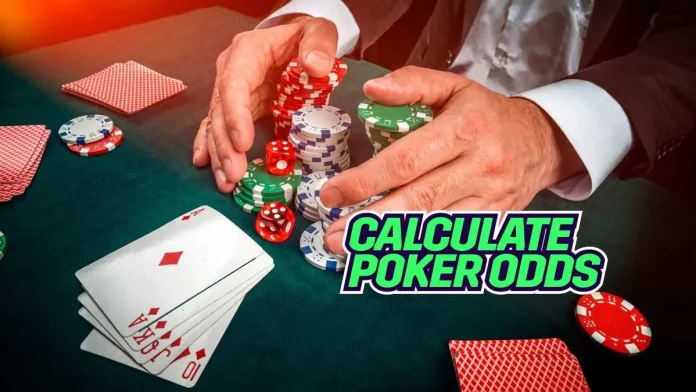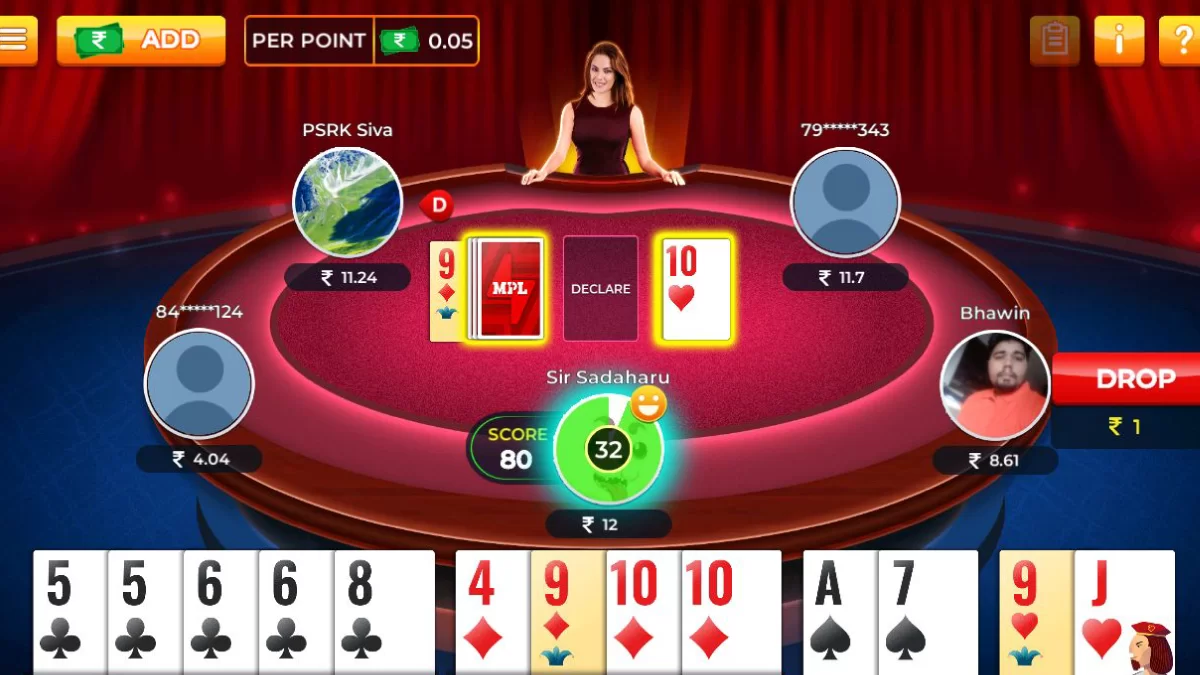You need to master certain poker skills to be a good player. Poker is not purely a game of luck but also requires specific strategies and mathematics. You need to be familiar with poker hands to calculate poker odds and refer to the poker odds chart. This blog will teach you how to calculate them and play poker like an expert.
How to calculate poker odds
You can poker odds for all versions like Texas hold’em poker odds (Hi-Lo 7), Stud Hi-Lo, and Razz. To calculate odds, do the following:
Calculate the tentative ranks and the number of your poker cards and those of your opponents.
Here, players have to calculate the total unseen cards. When the flop is dealt with on the table, there are a total of 2 hole cards, 3 Flop cards= 5 Cards. This shows that there are 48 unseen cards. (52-5).
For Texas Hold’em, follow these rules: there are 48 unseen cards, then 10 are outs, and the rest are losing cards. The relative odds according to calculations are: Losing cards= Outs/Winning cards= 38:10, which is 3:8:1.
Another shortcut for calculating poker odds is, that there are 10 outs when the flop is dealt, which means you have a 10×4= 40% chance of winning probability to get a winning card on Turn or River. 40% probability means 2:5:1 odds. After the turn, there is 10 outs, i.e 20% chance of winning. The Poker hand odds become 5:1.
Poker Odds Chart
The charts show your percentage of improvement on the flop and turn with some commonly made hands or draws. The following chart explains which poker pot odds are more likely to win in some standard hands.
Once you start playing poker often, you’ll calculate pot odds as you know them at the back of your hand, and you do not have to look at the charts anymore.
What Is a “Flip”
In poker tournaments, whether big or small, the flip is a ubiquitous term. You will be familiar with the term if you observe them in online poker rooms.
Two players are all in pre-flop, keeping their hands on their backs. Both hands are even odds to win- 50/50 or more similar to a coin flip. The most common situation is the classic pair bs. two overcards. e.g., A-K vs. 9-9 or A-J vs. 7-7. This flip works for any pair and overcards (even 2-2 vs. 3-4)
In truth, the odds aren’t 50/50, but in most cases, they’re close. However, the “made” hand is usually a slight advantage pre-flop. The J-T has a slight advantage in cases of a low pair versus well-coordinated overcards, like 2-2 vs. J-T.
More on Calculating Poker Hand Odds
More than poker strategy, playing a good game is all about mathematics and calculation of poker odds in real-time; the better you will be at making decisions at the poker table. If you have knowledge of your odds at winning at any point in a hand is a good way of accurately figuring out how better you are at winning against your opponent.
If you want to be a good poker player, calculate pot odds with a thorough thought process to estimate what are the most likely hands they are facing in any circumstance. This term is called “Putting Your Opponent on a Range” and is a crucial step in leveling up your game. Once you have figured out your opponent’s hand with the process of elimination, you can correctly apply your poker knowledge whether you’re playing in a casino or on online poker sites.
Pot Odds, Implied Odds, and More
Being poker players, they also have to consider a few sets of odds to understand where they are in a winning hand:
- Pot Odds and Implied Odds
- Reverse Implied Odds
- Hand Equity
What are Implied Odds?
A term that is taken with pot odds or outs is implied odds. It generally means how much you hope to earn later. For instance, if the pot size is 3:1 (an Rs .200 pot and Rs.100 bet), the winner will get Rs.300 when calling your rival’s Rs.100 bet. However, the odds will improve and decrease over time. They are a player’s ability to predict if they’ll gain more than a few by considering future bets. It can turn a losing call into a profitable call.
Reverse Implied Odds
Reverse implied odds suggests that if you make a draw, how much money you can lose in hand. This is the reverse of implied odds. This is the exact opposite of implied odds. It refers to the amount of money you lose after calling a bet. They are also a concept of pot odds.
For example, you have 6♥ 4♥ on the turn with the board reading A♠ J♦ 7♥ 2♥. Four players are in hand, and one of them bets Rs.75 into an Rs.100 pot. The other two players call, and you have to act now. It will cost you Rs.75 to call to win an Rs.325 pot, which means you need 18.75% equity for calling to show an immediate profit. You’re likely to hit a flush on the river 19.5% of the time, so calling might be possible. However, with the other three players, one of them can have a superior flush draw. Then, you’re on the way to losing at least another bet. Reverse implied odds refer to those losses. It can turn a winning call into a clear fold.
Hand Equity
When playing at a poker table, equity means the portion of the pot you will have provided that you win a hand at a certain time. In other words, equity is the percentage of time you win a hand in poker.
If you have Rs.180 in the pot and your chances of winning the hand are 50%, your equity in hand is Rs.90.
Counting Your Outs
Poker outs are cards that are not drawn yet, but when drawn, it will significantly improve the hand of the opponent. It should be straight draw and you must score six to strike a straight draw (4 and 5 of hearts and 6 of each color and seven and 8 of a diamond). There are 4 cards in the deck, which means you have 4 possible cards that could improve your hand.
Before you start calculating poker odds, you must know what outs are. Another example is when a person who is on the flush draw should have four hearts in hand and nine hearts remaining on the table so that you can flush. There are 13 suited cards, so 13-4= nine cards. Another example is a hand hitting two pair in a flip on your turn.
Poker Odds and Pot Odds
Poker odds are the probability you can expect to win or lose or the offer price. It can also define how often you need to have the best hand to call a bet. Every bet, raise or call that you make in no-limit hold’em has its own odds. To play poker, you should always think about good odds. , whether those you are getting offered or those are offering an opponent.
Pot odds are the ratio between the pot size and the size of the bet. If the starting pot is Rs.100 and a player bets Rs.50- i.e., half the pot- then the pot size is Rs.150, and the player is facing an Rs.50 bet.
- The pot odds are 15:5, and you must try to reduce the right side of the ratio down to one. The rules of ratio apply here, which is precisely the same as a standard mathematical equation.
- If you divide both sides by five, the ratio of pot odds become 3:1. You can convert this further into the percentage form. Add both sides together. Next, divide 100% by four, and you get four equal parts of 25% when you multiply both sides of the 3:1 ratio by 25% result and you 75%: 25% ratio.
- Using these calculations, if you know if your opponent bets half of the pot, then you can have an actual chance to have the best hand at least 25% of the time and make a call that profits you.
The rule of 4 and 2
The 4-2 Rule is a way of turning how many outs you have into your odds of hitting them. It’s 4 times on the flop to hit on the turn or river, and simply multiply 2 on the turn to hit your draw on the river.
E.g., a flopped flush draw is nine outs. Multiply this by 4, and the odds of hitting it by the river are 36%. With the same nine outs left on the turn, multiplying it by 2 gives you an 18% chance of hitting the river.
Basic Math – Odds and Percentages
Odds are meant as “for” or “again.” A formula for calculating poker odds from probability:
O = P / (1 – P).
The formula for calculating probability from odds is P = O / (O + 1).
Many websites provide a poker odds calculator; however, use these formulas to find the same.
How to Know When to Call a Bet?
In poker games, you often face bets with hands that have no showdown value but can have the most valuable hand. It can lead to the drawing if you call or raise. Basically a flush draw or a straight draw should be a good indicator of how you get a good chance of making the call on a draw.
Poker Odds: Why are they important to learn?
By calculating poker odds, players can tell how much money they have that they can gain. You can assume the probability in several ways- fractions, percentages, or odds. Poker is a combination of analysing skills and quick reasoning.
Calculated poker odds are the methods used by poker players in assessing current conditions of occurrence. Without understanding the odds, you can never create an income-producing plan. Don’t be afraid to tell how mathematical techniques affect your life. It takes a little practice, but it’s not as tricky as trying to learn a simple multiplication table.
Tell me the big question – should I call the bet?
If your opponent bets on a bet already there, it depends on the money in the pot. The pot odds are good. If they have less money, then they can win. Do not take huge sums of money then.
For e.g., Rs.40 is the amount you won, and Rs.10 is your contender has Rs.10 as the latest bet. Your odds are 9:1, which is good!
Poker drawing odds & outs
While playing poker and going for the big pot, you do not have an expertise in mathematics. However, you should have the best chance at knowing the odds. odds work in your favour to make good and bad bets in poker. The game decides what to do with it. As a poker player, this is an important aspect to note.
FAQs
How are pot odds calculated fast?
Pot odds are a simple calculation that you can try quickly. You must divide the amount of money you put in and make the call by the entire pot size. For example, if the starting pot is Rs.10 and one player bets half the pot- i.e., Rs.5, the player is facing a bet of Rs. 5.
What is the 2/4 rule in poker?
The rule of 4 and 2 is a quick and easy shortcut to calculate percentage odds and complete a draw in Hold’Em. To get percentage odds, do the following:
- When you are on the flop waiting for the turn, multiply your outs by 2.
- When you are on the turn waiting for the river, then multiply your outs by 2 again.
- Suppose the opponent is all in; multiply your outs by 4 when you are on the flop waiting for the river.
- After multiplying your hands either with 4 or 2, you will get a percentage that you can compare with your pot odds to see whether you can call a drawing hand or not.
How are card odds calculated?
Mathematicians measure probability using the similar principle of division and addition. For example, you add up the number of diamonds in a complete deck (13) and divide this by the total number of cards in the deck (52) to get the probability of randomly drawing a spade: 13 in 52, or 25 percent.










